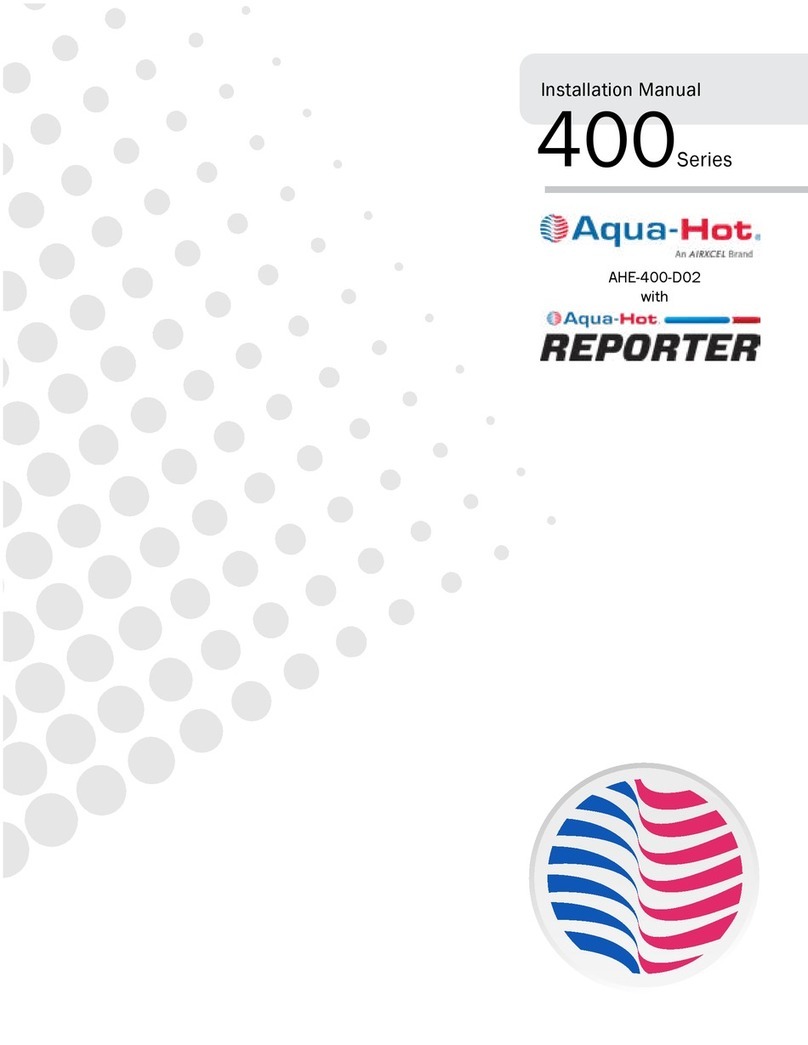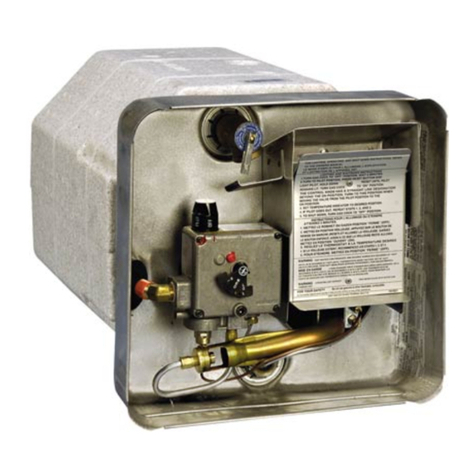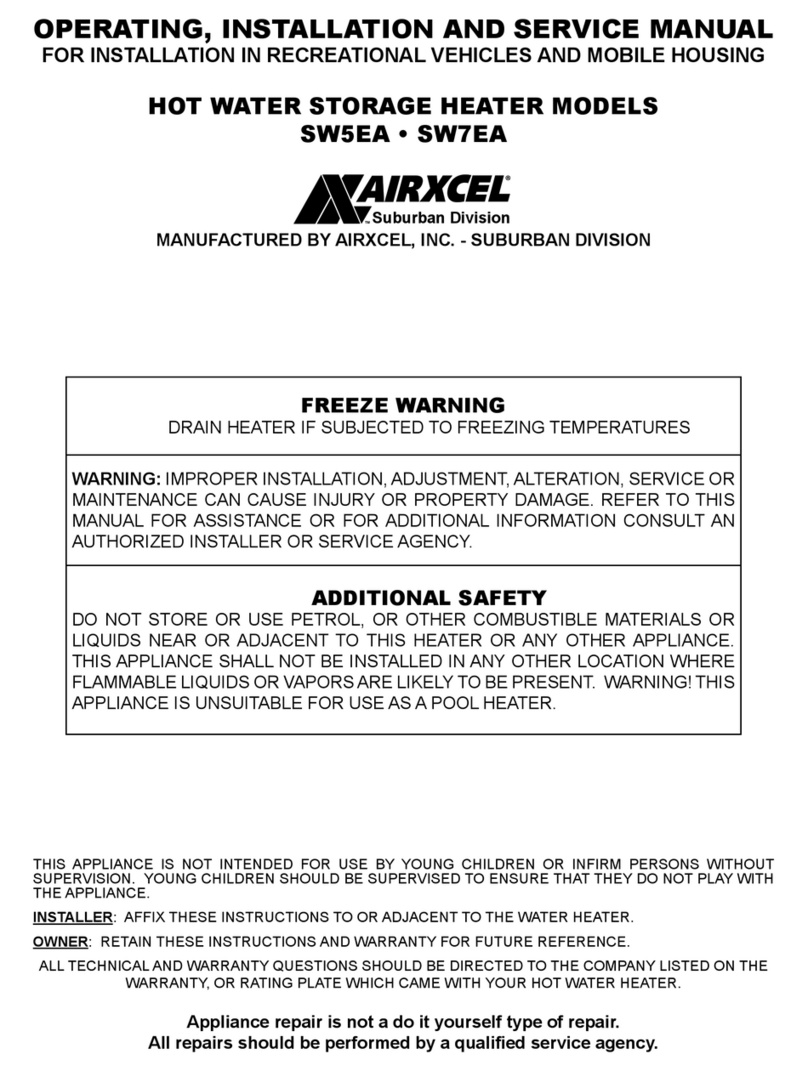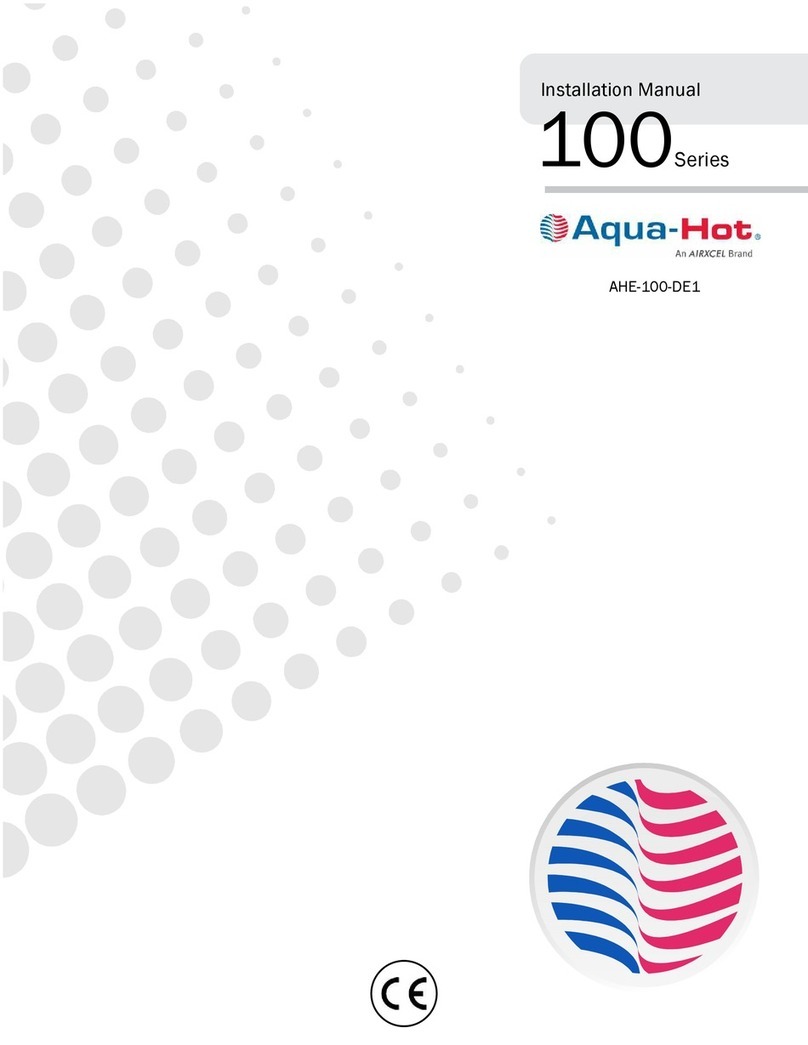
IntroductionIntroduction
©Aqua-Hot® 450D Installation Manual
REV
220504
©Aqua-Hot® 450D Installation Manual
REV
220504
p. 3p. 2
Safety Features
Low-Voltage Shutdown
The Aqua-Hot Reporter is designed to operate between 11V
DC and 16V DC. If the Reporter detects that it is receiving
voltage below 11.8V DC, a System Voltage fault will trigger
a display on the screen. If the Reporter system drops below
11.2V DC for 30 seconds, it will discontinue operation of
the Aqua-Hot heating system.
Over-Current
An Over-Current fault condition occurs when too much
current is drawn by a component, usually a fan or pump.
When this fault is triggered, the output channel is shut off
until the system has been reset or power-cycled.
Over-Temperature
An over-temperature fault will occur if your Aqua-Hot heating
system has reached 218°F. The Reporter will deactivate
the heater and display an over-temperature fault on the
display screen.
Low-Level Cutoff
If the system senses low uid levels, the heating system will
shut down all fans, heat sources, and pumps until the unit
is adequately relled.
Reporter “Heartbeat Function”
The Reporter units with rmware 1v5 and later and all
Reporter 2.0 units are equipped with a “heartbeat”
function that establishes a signal between the RV-C system
and the Reporter. The Reporter constantly awaits for a
signal from the RV-C network indicating to the Reporter that
it is to continue normal operation. Loss of 6 consecutive
signals from the RV-C network will trigger the Reporter to
deactivate the Aqua-Hot. Once power is restored to the
coach and the Reporter, “BATTERY DISCONNECT SWITCH
OFF” will be displayed in the fault log, indicating that the
Reporter lost connectivity with the RV-C network.
Manual Mode
The 2.0 Reporters with CFG 1.9 and greater come with a
manual mode in case the general coach RV-C network fails.
It will allow for limited operation while the larger network/
module problem is addressed.
Interlock Switch
The Aqua-Hot 450D is equipped with an interlock switch
that prevents the heater from operating when the cover is
not installed in the correct position or if it is not properly
secured in place. This is a safety device to ensure the
burner will not ignite if the service panel is not properly
secured.
Read all instructions before installing the Aqua-Hot unit. Aqua-
Hot Heating Systems is not liable for damage resulting from
failing to follow instructions contained in this, and any other
Aqua-Hot documentation relevant to this unit.
• Read this manual before installing or using the Aqua-Hot
System to reduce the risk of injury to persons or damage to
the equipment.
• The product identity label contains specications of the
unit, to what standards it has been tested, and important
safety notices.
• Disconnect electric wiring to the Aqua-Hot System before
welding or plasma cutting the coach to avoid damage to
equipment.
• The Aqua-Hot tank and heating loop operate at 0.0 PSI
(zero pressure system). Air pressure to the tank must not
exceed 20 PSI. Exceeding this rating will cause internal
damage to the Aqua-Hot.
• Use caution when working on or near any propane/diesel
fuel system.
• DO NOT connect the 12-volt DC power to the Aqua-Hot if the
vehicle requires welding.
• At maximum operating temperature, the coolant will be
very hot and scalding. Hot vapor or coolant may cause in
serious burns or injury. Be aware of hot surfaces.
• Installation and repairs may only be carried out by an
authorized, factory-trained Aqua-Hot technician. The
heating system must be installed in accordance with local
codes, or in accordance with the Standard for Recreational
Vehicles, (RVIA) ANSI A 119.2/NFPA 501C, NFPA 1192.
• Aqua-Hot will not be liable for problems or damage caused
by the system being installed by untrained personnel.
System Overview
The Aqua-Hot 450D is a Hydronic (water-based) Heating
System, a tank-less hot water system, and a diesel engine
preheating system.
The heating system provides moist, quiet, comfortable,
interior heat with up to 5 separate, thermostatically-controlled
temperature zones, and prevents tank and line freezing in the
bays.
The tank-less hot water system produces 90 gallons per
hour of continuous, on-demand hot water.
The diesel engine preheating system circulates the engine’s
antifreeze solution through an internal heating loop in the Aqua-
Hot and pumps it back through the engine, raising the engine’s
temperature from 30°F to 90°F in about 1 hour.
The same heating loop that preheats the diesel engine
allows the Aqua-Hot system to take surplus heat generated by
the motor home’s diesel engine while running, and use it to
heat the Aqua-Hot system.
This TribridHot™ designated system uses one or a
combination of heat sources to heat FDA-Approved Generally
Recognized As Safe (“GRAS”) Propylene Glycol-based antifreeze
solution in the Aqua-Hot’s boiler tank.
The 450D has multiple heating sources: the motor home’s
engine’s surplus heat (while driving), one 120V AC - 1650W
Electric Element (when plugged into shore power), and a 12V
DC powered diesel burner (when dry camping). These heat
sources can be used separately or simultaneously.
New Low Emissions Technology virtually
eliminates smoke and odor from the exhaust
by reducing total hydrocarbon emission by
82%, making Aqua-Hot the cleanest burning diesel-powered
hydronic heating system available.
Should additional assistance be needed, please contact the
Technical Support at 574-AIR-XCEL (574-247-9235), Monday
through Friday, between 7:00am and 4:00pm MST.
Important Notes:
• A qualied installer or service technician must perform
equipment installation or service. Contact Aqua-Hot for
Factory Authorized Service Centers or Certied Technicians
located near you at www.aquahot.com/service-help, or call
us at 574-AIR-XCEL (574-247-9235).
• Warranty work must be performed by an Aqua-Hot
Authorized Service Center.
• Your on-product identity label contains the specications of
your unit. Factory settings may be adjusted by the vehicle
manufacturer, conrm nal setting with your dealer.
• This heating system has been certied for installation only
in recreational vehicles, not certied for use in boats.
• The Aqua-Hot heating system operates independently of
the vehicle engine and is connected directly to the electrical
system of the vehicle.
• Please read this manual and follow instructions to avoid
injuries during installation and/or operation.
Hot Water Priority System
The Aqua-Hot 450D is a Hot Water Priority heating system.
Meaning that the 450D cannot heat the interior of the coach
and produce hot water simultaneously. When hot water is being
used, the interior heating system will shut off temporarily, until
hot water is no longer being used.
When hot water is requested, domestic water from the
coach’s fresh water tank is transported through a copper coil
in the Aqua-Hot’s boiler tank where heat is transferred from
the heated antifreeze and distilled water solution. The heated
domestic water then ows through the tempering valve to be
mixed with cool water from the fresh water tank to achieve an
appropriate temperature before it ows to the faucet.
As with any appliance, allow the Aqua-Hot to completely shut
down BEFORE disengaging the coach 12V power disconnect.
If the information in this manual is not followed
exactly, a re or explosion may result, causing property
damage, personal injury or death.
NOTE: For networked control of the Reporter, Aqua-
Hot requires system integrators ensure that individual
commands are received and processed. Aqua-Hot requires
that commands be repeated or conrmed so that if a
single message were dropped, or if there is a brief network
disturbance, the Reporter would get into the correct state as
soon as the disruption was removed.
The Aqua-Hot Reporter monitors the heating system and
handles all logic relating to safeties and heating control.
As such, the system integrator is required to display all
pertinent status information but not use that information to
lock out operation or add additional safety layers that could
impact the end of operation if a message from the Reporter
was missed.
































